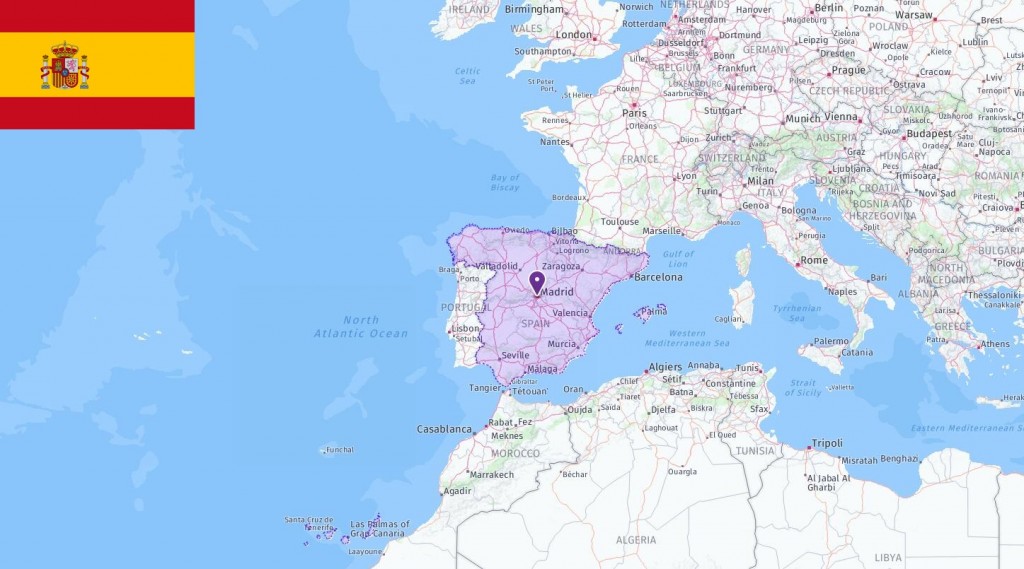ES is the abbreviation for Spain, the 51st largest country in the world. Officially the Kingdom of Spain, Spain is a country located in Europe, bordering 4 countries – Andorra, France, Gibraltar, and Portugal. Madrid is the capital city of Spain. Major cities include Madrid (population: 3,255,933), Barcelona (population: 1,621,526), Valencia (population: 814,197), Seville (population: 703,195), Zaragoza (population: 674,306), Málaga (population: 568,294), Murcia (population: 436,859), Palma (population: 401,259), Las Palmas de Gran Canaria (population: 381,836), and Bilbao (population: 354,849).
Country Profile
- Capital: Madrid
- Language: Spanish
- Area: 505,990 km2
- Population: 46,934,621
- Currency: Euro (€) (EUR)
- Time zone: UTC+1
- Calling code: 34
- ISO 2-Letter Abbreviation: ES
- UN 3-Letter Abbreviation: ESP
- Internet TLD: .es
- State Government Website: http://spain.info
List of Spain Acronyms
The most commonly used abbreviations about Spain are ES which stands for Spain and EUR which means Euro (Spain currency). In the following table, you can see all acronyms related to Spain, including abbreviations for airport, city, school, port, government, and etc.

Geography
Spain is one of the most mountainous countries in Europe. The Pyrenees in the northeast and Sierra Nevada in the southeast are the largest mountain massifs in the country, while the Cantabrian mountains rise to 2600 meters above sea level northwest of the country. In the middle of the country lies a highland plateau almost without trees, with poor soil and harsh climates. Large rivers such as Ebro and Guadalquivir flow around the mountain massifs. Along the coast to the north and south there are fertile plains. The height differences mean that there are large variations in climate between the regions of the country. The northern coast typically has a Atlantic climate, while the southern parts of the country are considerably warmer. In the central inland it can get up to 40 degrees of heat in the summer, and considerably much colder than the rest of the country in the winter.
Erosion and frequent fires in the summer months threaten the large forest areas in the country, and the authorities have started extensive planting. Spain struggles with high air pollution, and is vulnerable to pollution in the Mediterranean and to emissions from passing oil tankers.
History
The Iberian Peninsula has been inhabited by many peoples since 16,000 BCE, including Phoenicians, Carthaginians and Romans. When the Baghdad Caliphate conquered the peninsula in the 7th century, Arab Spain emerged as a cultural, scientific and economic center in southern Europe.
Towards the end of the 14th century, Spain was united for the first time into an independent kingdom. And when Christopher Columbus traveled to South and Central America and declared these territories as Spanish territory, Spain quickly became the most powerful country in Europe. Spain remained a great power until the 19th century, when it began to lose control of its colonies.
After many years of financial problems and dictatorship in Spain, a bloody civil war broke out in 1936. There, the forces of fascist Francisco Franco took control of the country, establishing a new dictatorship that lasted until his death in 1975.
After Franco’s death, the country quickly developed a functioning democracy. During the 1980s, a number of new social reforms came, and Spain became an important part of European cooperation, including joining NATO in 1982 and the EU in 1985.
Society and politics
Spain is a constitutional monarchy where the king has minimal power. The executive power lies with the prime minister who is elected in democratic elections. In the decades following General Franco’s rule, the moderate right-wing party Partido Popular (PP) and the Socialist Party (PSOE) have been the most important parties in the country. Both parties have ruled against the political center, and have been willing to compromise to achieve political results.
Spanish politics is characterized by the tension between the central power and the country’s 17 regions, where the Basque country and Catalonia in particular have gained considerable internal autonomy through their own elected parliaments. Several of the regions have their own police forces and control their own customs regulations. Disagreement between the government of the capital Madrid and the separatist movement in the Catalonia region has developed into a difficult and important political issue.
Economics and Commerce
From being a poor agricultural country in the early 1980s, Spain has developed an advanced and strong economy with industry and a varied range of services. The tourism industry has been particularly important and in 2018 Spain was the country in the world with the most tourists. The large regional differences are evident in the economy. In the area around Madrid and further north towards the Atlantic coast, income and employment are far greater than in the southern regions of Andalucia and Extremadura. With the strong economy, Spain was one of the founders of the European Monetary Union in 1999.
Spain was hit hard by the global economic crisis in 2008 and unemployment rose sharply. At the beginning of 2013, unemployment was over 26 per cent, one of the highest in Europe. From 2014, the Spanish economy has gradually recovered. Even the country is struggling with high unemployment, especially among young people. It is especially the many young people in the private sector, for example in the service profession and the construction industry, who are struggling to find a job. This is considered a major societal problem.
View this article in other languages:
Deutsch – Français – 繁體中文


